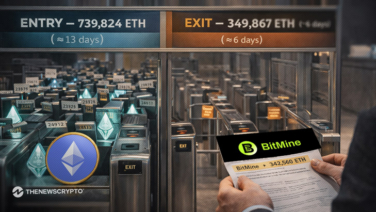- Vitalik says a structured governance model is needed for secure upgrades.
- Decentralization remains crucial, but user participation in governance is low.
Vitalik Buterin’s latest piece, “Possible Futures for the Ethereum Protocol, Part 4: The Verge,” delves into critical aspects of Ethereum’s future, focusing on scalability, security, and the need for robust governance mechanisms. Buterin emphasizes the urgency of addressing these challenges to ensure Ethereum’s long-term viability.
One core topic Buterin discusses is scalability, particularly the implementation of Layer 2 solutions. He highlights that while Ethereum has made strides with rollups, further innovation is necessary. Rollups, which bundle multiple transactions into a single proof, help increase throughput.
Possible futures of the Ethereum protocol, part 4: The Vergehttps://t.co/ij3wtBByeY
— vitalik.eth (@VitalikButerin) October 23, 2024
However, the challenge lies in maintaining decentralization while scaling. Buterin advocates for enhancing interoperability between Layer 1 and Layer 2 systems, ensuring a seamless experience for users. He notes that developing effective bridges between chains can facilitate the transfer of assets and data, enhancing overall network efficiency.
Vitalik Buterin’s Solutions for Ethereum’s Security
Buterin addresses the security of the Ethereum protocol, pointing out that as Ethereum scales, the attack surface increases. For instance, he proposes improving the security of the Ethereum Virtual Machine (EVM) to protect against vulnerabilities. Enhancing the EVM’s robustness could involve introducing formal verification methods and developing better programming languages like Vyper that prioritize security. These languages can reduce the risk of common vulnerabilities such as reentrancy attacks and integer overflows.
Another aspect Buterin explores is governance within Ethereum. The current governance system, while functional, often excludes users who lack the technical knowledge to engage. Buterin suggests developing user-friendly governance tools, such as decentralized autonomous organizations (DAOs), that simplify the process of contributing to decision-making.
Buterin introduces the concept of on-chain governance, where protocol upgrades are decided through community votes. He envisions a system where stakeholders can propose and vote on changes in a transparent manner. This model can use mechanisms like quadratic voting, which allows users to express the intensity of their preferences, thus enhancing accountability.
Moreover, Buterin emphasizes the need for continuous research and development. He calls for more investment in Ethereum’s infrastructure, particularly in areas related to zero-knowledge proofs (ZKPs) and optimistic rollups. ZKPs can enable private transactions while maintaining security, while optimistic rollups can enhance scalability by processing transactions off-chain.
Finally, Buterin discusses the potential for layered security mechanisms that can enhance the overall resilience of the Ethereum protocol. By integrating multi-signature wallets and decentralized identity systems, Ethereum can provide users with greater control over their assets and reduce risks associated with centralized management.
Highlighted Crypto News Today
Sky Branding Dilemma Deepens Amid Founder’s Transactions








